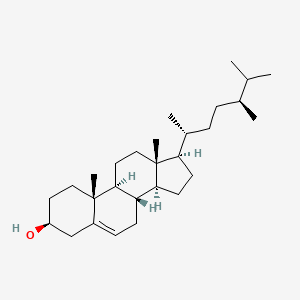| MeSH term | MeSH ID | Detail |
|---|---|---|
| Coronary Disease | D003327 | 70 associated lipids |
| Hypercholesterolemia | D006937 | 91 associated lipids |
| Hyperlipoproteinemia Type II | D006938 | 22 associated lipids |
| Hyperlipidemias | D006949 | 73 associated lipids |
| Hypolipoproteinemias | D007009 | 9 associated lipids |
| Xanthomatosis | D014973 | 17 associated lipids |
| Metabolic Syndrome | D024821 | 44 associated lipids |
22,23-dihydrobrassicasterol
22,23-dihydrobrassicasterol is a lipid of Sterol Lipids (ST) class. 22,23-dihydrobrassicasterol is associated with abnormalities such as Diabetes, Macular degeneration, Drusen, Systemic disease and Diabetes Mellitus. The involved functions are known as cholesterol metabolism, Synthesis, Intestinal Absorption, Liver function and cholesterol absorption. 22,23-dihydrobrassicasterol often locates in Back and Cell membrane. The associated genes with 22,23-dihydrobrassicasterol are apolipoprotein E-3. The related lipids are Total cholesterol, campesterol, lathosterol, Fatty Acids, Nonesterified and Cholesterol, Dietary.
Cross Reference
Introduction
To understand associated biological information of 22,23-dihydrobrassicasterol, we collected biological information of abnormalities, associated pathways, cellular/molecular locations, biological functions, related genes/proteins, lipids and common seen animal/experimental models with organized paragraphs from literatures.
What diseases are associated with 22,23-dihydrobrassicasterol?
22,23-dihydrobrassicasterol is suspected in Diabetes, Macular degeneration, Drusen, Systemic disease, Diabetes Mellitus, Liver diseases and other diseases in descending order of the highest number of associated sentences.
Related references are mostly published in these journals:
| Disease | Cross reference | Weighted score | Related literature |
|---|
Possible diseases from mapped MeSH terms on references
We collected disease MeSH terms mapped to the references associated with 22,23-dihydrobrassicasterol
PubChem Associated disorders and diseases
What pathways are associated with 22,23-dihydrobrassicasterol
There are no associated biomedical information in the current reference collection.
PubChem Biomolecular Interactions and Pathways
Link to PubChem Biomolecular Interactions and PathwaysWhat cellular locations are associated with 22,23-dihydrobrassicasterol?
Visualization in cellular structure
Associated locations are in red color. Not associated locations are in black.
Related references are published most in these journals:
| Location | Cross reference | Weighted score | Related literatures |
|---|
What functions are associated with 22,23-dihydrobrassicasterol?
Related references are published most in these journals:
| Function | Cross reference | Weighted score | Related literatures |
|---|
What lipids are associated with 22,23-dihydrobrassicasterol?
Related references are published most in these journals:
| Lipid concept | Cross reference | Weighted score | Related literatures |
|---|
What genes are associated with 22,23-dihydrobrassicasterol?
Related references are published most in these journals:
| Gene | Cross reference | Weighted score | Related literatures |
|---|
What common seen animal models are associated with 22,23-dihydrobrassicasterol?
There are no associated biomedical information in the current reference collection.
NCBI Entrez Crosslinks
All references with 22,23-dihydrobrassicasterol
Download all related citations| Authors | Title | Published | Journal | PubMed Link |
|---|---|---|---|---|
| Wewer V et al. | Quantification of sterol lipids in plants by quadrupole time-of-flight mass spectrometry. | 2011 | J. Lipid Res. | pmid:21382968 |
| Kurano M et al. | Plant sterols increased IL-6 and TNF-α secretion from macrophages, but to a lesser extent than cholesterol. | 2011 | J. Atheroscler. Thromb. | pmid:21266789 |
| Vanmierlo T et al. | Cerebral accumulation of dietary derivable plant sterols does not interfere with memory and anxiety related behavior in Abcg5-/- mice. | 2011 | Plant Foods Hum Nutr | pmid:21431910 |
| Shafaati M et al. | Marked accumulation of 27-hydroxycholesterol in the brains of Alzheimer's patients with the Swedish APP 670/671 mutation. | 2011 | J. Lipid Res. | pmid:21335619 |
| Sabeva NS et al. | Phytosterols differentially influence ABC transporter expression, cholesterol efflux and inflammatory cytokine secretion in macrophage foam cells. | 2011 | J. Nutr. Biochem. | pmid:21111593 |
| Miettinen TA et al. | Non-cholesterol sterols in serum and endarterectomized carotid arteries after a short-term plant stanol and sterol ester challenge. | 2011 | Nutr Metab Cardiovasc Dis | pmid:20096545 |
| Neil HA et al. | Impact of atorvastatin and omega-3 ethyl esters 90 on plasma plant sterol concentrations and cholesterol synthesis in type 2 diabetes: a randomised placebo controlled factorial trial. | 2010 | Atherosclerosis | pmid:21036355 |
| Chung HY et al. | Simultaneous suppression of three genes related to brassinosteroid (BR) biosynthesis altered campesterol and BR contents, and led to a dwarf phenotype in Arabidopsis thaliana. | 2010 | Plant Cell Rep. | pmid:20169349 |
| Clément C et al. | Influence of colour type and previous cultivation on secondary metabolites in hypocotyls and leaves of maca (Lepidium meyenii Walpers). | 2010 | J. Sci. Food Agric. | pmid:20355123 |
| Rossard S et al. | Ergosterol triggers characteristic elicitation steps in Beta vulgaris leaf tissues. | 2010 | J. Exp. Bot. | pmid:20304987 |
